So Raw has been and gone for another year. Raw Wine seems now to be a real community – a group of artisans who know each other, so the vibe is always friendly and buzzing. If anyone doesn’t know Raw Wine, it is more than anything a platform for artisans making low impact and minimal intervention wines and other beverages. All the wines at Raw are almost additive free (some producers add a small amount of sulphur to stabilise their wine), and most should be vegan friendly too, a fact which demands promotion.
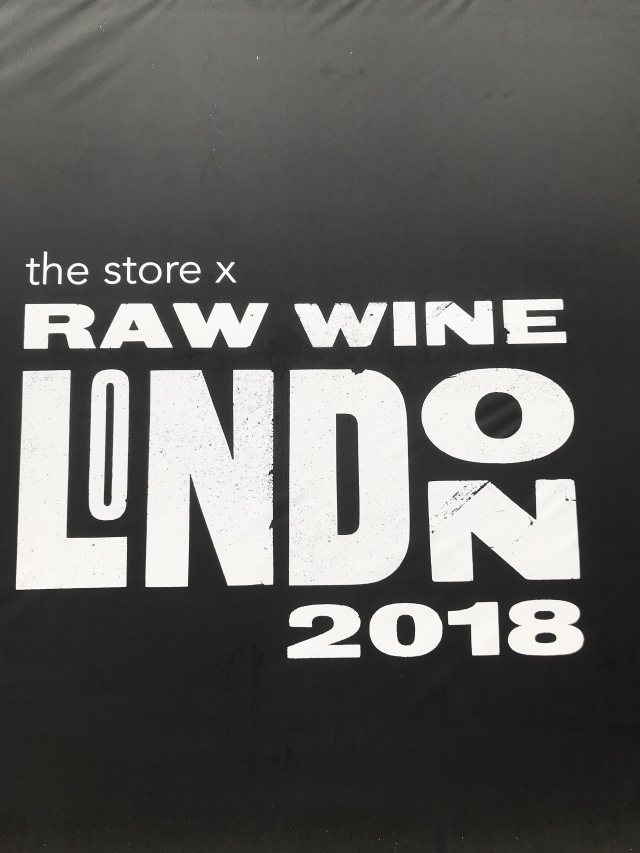
The Festival seems comfortable in its new home for the second year at The Store on The Strand, which is central and very convenient to many of us. I attended on the Trade/Press Day (Monday), which only got crowded by mid-afternoon, at which point a few of the exhibitors were noticeably flagging. But Raw seems to grow in confidence and the vibe is always great, even when there’s a crush around the better known producers. Getting there relatively early, I had a chance to focus on tasting in peace, if not quiet.
There’s a decent food offering upstairs at The Store, which is another reason I like the venue. Retreating up there to take stock over a decent coffee allows a rare moment of relaxation amid the bustle of the Fair. At the end of the day it was especially nice to be able to pick up a couple of bottles from the Burgess & Hall pop-up shop. Forest Gate E7 might not be the easiest place to get to for out-of-towners like me (though having lived there for a few months in my distant past, at least I know where it is), but their selection was enough to persuade me I must get out and visit them this summer.
As usual, I have tried to include quite a few new names along with some old friends, although I’ve missed out some of the big names, I’m afraid. They will probably get plenty of coverage elsewhere. In this Part 1 all the producers are French. Part 2 covers the rest of Europe, plus (randomly) Canada and Sake, and will be slightly longer.
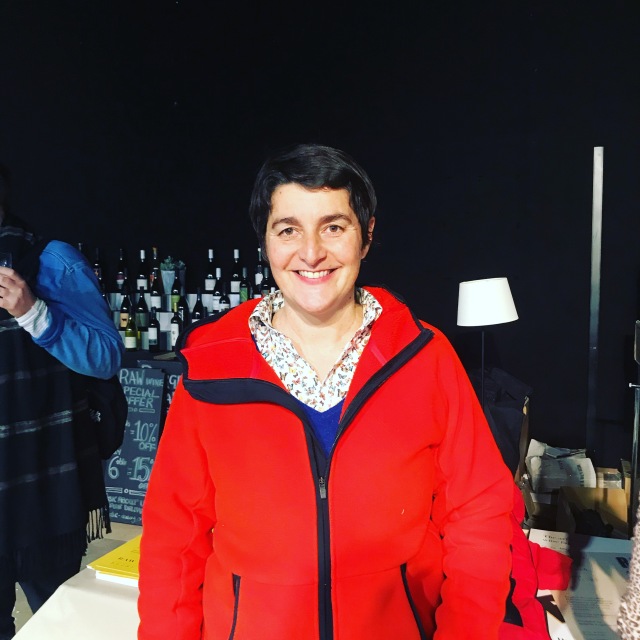
The lady to whom we owe so much, Raw Wine founder Isabelle Legeron
DOMAINE GESCHICKT (Alsace)
This Ammerschwihr producer is run by Arnaud and Frédéric Geschickt and Aurélie Fayolle. They have been biodynamic since 1998, making “natural wines” since 2012, with a range of vineyards, including on the village’s great crus, Kaefferkopf and Wineck-Schlossberg.
Ten wines were on show, beginning with a fresh and very dry Crémant “Double Zero” 2015 from a blend of Chardonnay, Pinot Blanc and Riesling, through a couple of Grand Cru Kaefferkopf and an interesting Pinot Noir, to the orange wines.
Riesling Geschickt 2016 saw a slow eight hour press rather than strict skin contact, so the colour is a little darker. It’s round and rich but also mineral dry.
The two Grand Crus were very good, from a site which wasn’t named in the original Grand Cru designation, but which just about everyone screamed that it should have been. My favourite was a 2015 blend of Riesling with Pinot Gris and Gewurztraminer off the part of the Kaefferkopf vineyard on clay and limestone. Fruity and floral yet with good acid balance and structure, this wine is a little different. It will age a decade if you want. It was partnered with a Kaefferkopf Riesling, both 2015.
The skin contact wines were very much to my taste. Le Schlouk 2016 (the sip) is a very orange blend which everyone should try. Blending Gewurztraminer and Riesling, it’s both rich and dry, and would pair with salmon or trout, or possibly even better with soft cheeses.
Last but not least here, Obi Wine Keno Bulle 2017 is a complicated name for a deliciously simple Muscat/Pinot Auxerrois petnat. It’s hand disgorged so a little cloudy/hazy, quite acidic but with a biscuit character not usually associated with pétillant-naturel. The fruit is like refreshing pineapple, so it’s a real thirst quencher.
This is a really good range and I’m quite surprised they don’t have any UK representation…yet (I hope).
DOMAINE LAURENT (Stéphane) BANNWARTH (Alsace)
I won’t duck the issue, Bannwarth seemed to polarise opinion among those I spoke to. As I was extolling these wines, I experienced some agreement, and a little dissention. I’m not sure why, exactly. I thought these wines were brilliant, if slightly “out there”.
Based in Obermorschwihr (south of Colmar and Eguisheim), they make two types of wine, one based on the fruit of the traditional grape varieties, and one style produced in Georgian Qvevri (since 2011). Even the wines made in the qvevri show really good (and very obviously healthy) fruit, which is very much at the heart of viticulture at Bannwarth.
I began with Red Bild 2015. It’s not Pinot Noir, but the pink skinned Pinot Gris, which has undergone two weeks maceration. This ripe vintage yielded good colour from the skins, but it’s a lovely pale hue, almost like a dark partridge-eye. A bit of a one-off, but highly recommended. Riesling Coeur de Bild 2013 comes off chalky soil and has a real lime zest quality…depth, freshness and zip.
The three orange wines all show different winemaking techniques, and all of them are out there on the edge, but in my view were all very successful (if for the adventurous), thrilling even. La Vie en Rose 2016 might mislead a little. It’s not a rosé! Gewurztraminer has two weeks maceration on skins in stainless steel. The bouquet is beautiful, but the palate is as textured as one would expect.
Pinot Gris Qvevri 2014 does just what it says on the label…amphora-made orange wine which is lovely and full in the mouth. Synergie Qvevri 2015 mixes Pinot Gris with Gewurztraminer and Riesling with eight months on skins, all three varieties co-fermented in amphora. It begins as a softer, gentler, wine, but with more underlying skin contact texture.
Like Geschickt, Laurent Bannwarth has no UK importer. I hope someone wakes up to these really interesting, if possibly challenging, wines. They would be well worth a visit for anyone heading over to the region.
LE VIGNOBLE DU REVEUR (Alsace)
Le Vignoble du Rêveur is the domaine of Mathieu Deiss and Emmanuelle Milan, based at Bennwihr. Going his own way, although he still also works with his famous father, Mathieu (with Emmanuelle) has amassed seven hectares, largely from his maternal uncle and grandfather, on alluvial soils close to the northern edge of Colmar. The wine, around 40,000 bottles each vintage, is made at Domaine Marcel Deiss in Bergheim.
There are six wines produced under the “Rêveur” label. The first three are made by direct pressing, natural fermentations, and one year ageing in foudre on fine lees. Vibrations 2016 is a real terroir wine, Riesling off Bennwihr’s alluvial terrain. La Vie en Rose 2016 has the same name as the Bannwarth wine, and guess what, it’s also Gewurztraminer, in this case from 40-year-old vines. Pierres Sauvages 2016 is a blend of Pinot Gris, Pinot Blanc and Pinot Noir. The name kind of does the explaining, I think.
Singulier 2016 is a quite exotic Gewurztraminer aged in big oak after a short ten-day maceration, and no sulphur is added. It has a textured finish. Artisan 2016 is made the same way, but blends Gewurztraminer with Pinot Gris. It has a cloudy, peachy colour, and is rounded with a bittersweet skin texture. Possibly my favourite wine here.
Un Instant sur Terre 2016 is the other contender for me. It’s also made from a blend of Gewurztraminer and Pinot Gris but it sees six months on skins in amphora (interestingly, the vessels in which the Gewurz is aged are made from sandstone, and those for the Pinot Gris, clay). Then the components are aged together in stainless steel for six months to knit together. The alcohol in this 2016 is reasonably high at 14.5%, but the wine is balanced and already showing interesting hints at complexity.
Mathieu and Emmanuelle do have an importer, Roberson, so you should be able to find them. They are some of the most exciting wines coming out of Alsace from a young grower who has not taken the easy path of merely shadowing a famous parent. As the domaine name suggests, Mathieu has a dream.
DOMAINE DE VALMENGAUX (Bordeaux)
It’s not too often I write about natural wine from Bordeaux. David and Valérie Vallet make two wines (two vintages of each were shown), but the vines, just under two-and-a-half hectares, are owned by a group of fifty investor-friends. Valmengaux has only been in their hands since 2017, but they are clearly enjoying the challenge. Their primary aim is healthy grapes. Around 90% of the vines are Merlot (they are around 20km from Saint-Emilion, at Verac), with the remainder Cabernet Franc and Cabernet Sauvignon.
Domaine de Valmengaux is a “Bordeaux AOP” vinified fairly traditionally, and Valmengaux “En Jarre” is made in amphora under the same AOP. I tried both 2015 and 2016 vintages. The more traditional wine from both vintages is clearly an easy drinking natural wine, with delicate tannins, 2015 being (as one would expect) somewhat richer.
The amphora wines were more characterful, aromatic and with a more interesting (for me) texture, but that’s not in any way to dismiss the other cuvée. These are all “drinkers”. There is no pretence at making wine with tannin and oak, meant to sit in a cellar for a decade. Both wines will cost less than £20. It’s the kind of wine Bordeaux needs to produce – affordable wine for actually drinking, not trading.
Amphora Bordeaux is not new. I tried one several years ago (and some of the top châteaux are experimenting), but that one, although a natural wine, was very expensive. These wines aren’t. They currently have no importer in the UK and I think that they would sell.
DOMAINE PHILIPPE VIRET (Rhône)
There are plenty of big names in the natural wine world making wines in the Rhône Valley, but the Virets make wine using a method I’ve not come across before, “cosmoculture”. I am still not totally sure what “cosmotelluric changes” are or involve, but it is something to do with the vines generating their own defence to threats from disease etc. It sounds like a variation of biodynamics, but I think it also involves magnetic lines, underground water, the metal elements in the soil and the way in which earth and sky interact.
Whatever cosmoculture might be, the Virets are obviously doing something right in their vineyards between Gigondas and Châteauneuf. Seven wines were on show, and winemaking is dominated by amphora use. Philippe may have been the first producer in France to dedicate his production to amphora. He now has twenty or so, each holding 420 litres of wine. The move to amphora came after blind tasting Sicilian wines made by this method, but also because there are Roman remains on the property.
The wines all have different personalities, but the one I found immediately attractive was labelled Dolia Paradis Ambré 2, 2016. It’s a deliciously textured amphora wine with subtlety and delicacy, yet equally strong presence. It’s an amazing blend of (if I counted correctly) thirteen Rhône varieties off clay, sandstone and limestone. No sulphur, no temperature control, no intervention, no nothing. These wines are new to Winemakers Club.
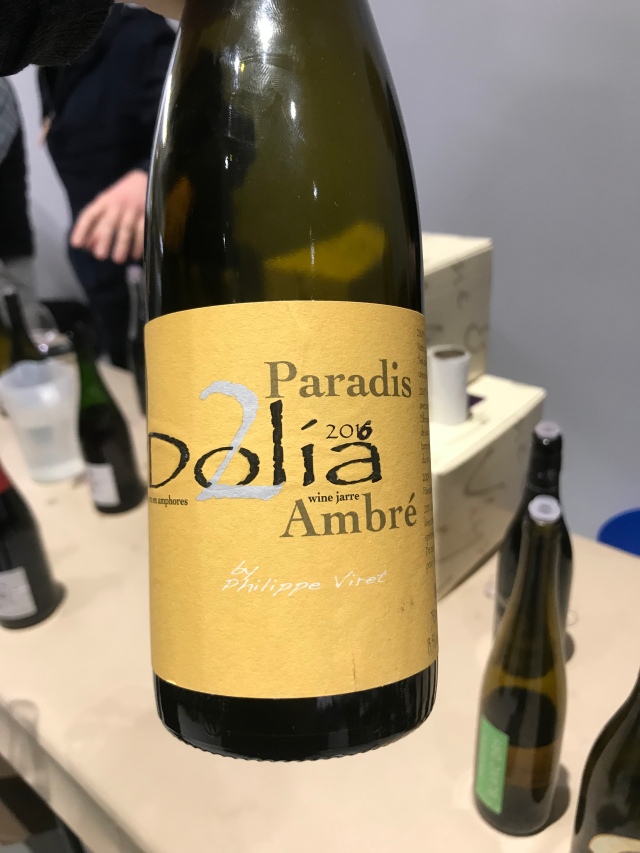
KARIM VIONNET (Beaujolais)
It’s always a pleasure to taste Karim’s wines, and I get the opportunity to do so fairly regularly, and to write about them. But the reason for including him again here is that, when I’ve hardly begun tasting the 2016 vintage, Karim had some 2017 samples at Raw: Beaujolais-Villages, Du Beur dans les Pinards and Chiroubles “Vin de Kav”.
The 2017 vintage has been described as somewhere between 2015 and 2016. Or, as someone put it, “a bit like 2015 but still Beaujolais”. That might be a bit unfair to a few 2015s, but I’m sure Beaujolais fans know what they mean. Vintage 2017 was affected once again by hail, but the grapes that were spared were ripe and healthy at harvest. Alcohol levels are thankfully down on ’15.
All three of these wines will hopefully be on my list to buy when eventually bottled. The “Villages” is very fruity and silky, perfect glouglou, yet it’s not lacking in structure. “Du Beur” gives plenty of deeper, rounded cherry fruit. “Vin de Kav” always seems to over deliver for me. Not one of the famous crus, but it doubles up on great fruit and structure. It needs a little time, but not too much.
A treat to finish with, a delicious and very “off-dry” petnat, Grabuge. It’s a gorgeous bright pink, with quite high residual sugar and 7% abv. A perfect summer afternoon tipple which would also double as a perfect breakfast wine (oops, I see I’m not the first to suggest such debauchery with one of these) once it’s warm enough to stick the table on the patio. I somehow neglected to photograph this, but I think Winemakers Club is only getting around 36 bottles. I hope the promise of one for me is strictly adhered to. I know what some of you dear readers are like (vultures).
L’EPICURIEUX (Beaujolais)
Sébastien Congretel’s wines are not only new to me, but new to everyone I think. 2016 was his first vintage, and from what he was saying, he is totally new to winemaking. Sébastien has worked in the oil industry, being away from home for long periods. For him, it was all about a total change in lifestyle. Despite his inexperience, he’s crafted two lovely wines from his first attempt. Having a father-in-law who made wine in Lantignié helped, not least in providing a chais, but these are not the run of the mill wines of a back to the countryside city type. Sébastien has talent.
His Régnié “Chacha” 2016 is made from 40-year-old vines at 200 metres altitude on sand and alluvial soils. Morgon “Zelebrité” 2016 comes from even older (70-y-o) vines at the top of the Charmes lieu-dit at 450 metres, on pink granite. Both wines come in at 12%, from ten days carbonic maceration, two days pumping over and a gentle press. They are aged in 5 to 7-y-o oak and a 2,500 litre foudre with the assemblage a blend of the two sources for each cuvée. Sébastien adds 2 g/l suphur three weeks before bottling.
Both wines are delicious, the Régnié being the more forward, as expected. The Morgon has really tasty cherry fruit, and is plumper, but with more structure. Sébastien will get his organic certification through in 2019, but he is working using biodynamic principles. He has no UK representation, but I’m sure that will change – so many people were saying “have you tasted…?” and by luck I did as he was right next to Karim’s table. Annoyingly he was relieving himself of a few remaining bottles which he didn’t want to have to lug back to France. If I’d had space and no after party to go to, I’d have grabbed a couple, using my elbows.
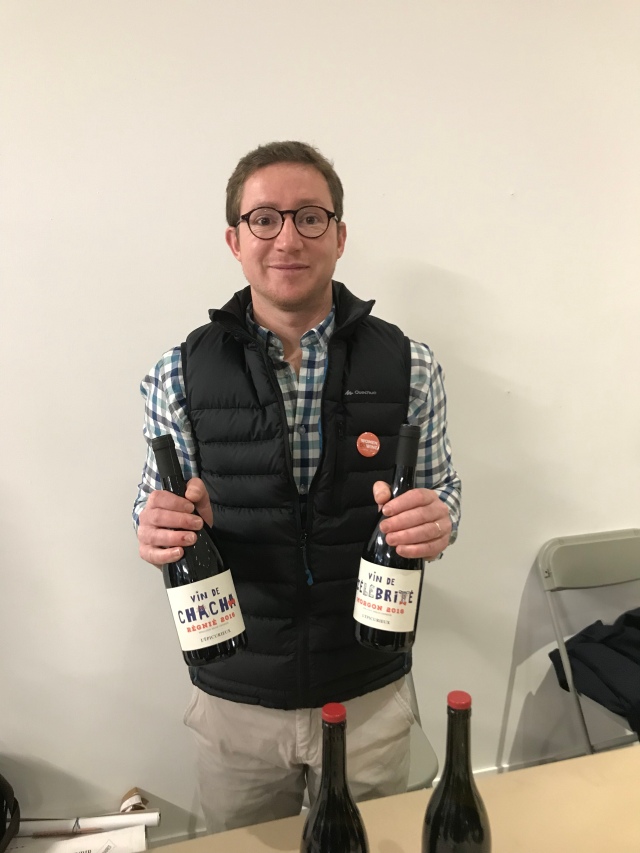
DOMAINE YVES DUPORT (Bugey)
Okay, I know I always taste these wines, but Bugey deserves a plug in the “Year of Savoie”, its near neighbour. Yves and his wife farm around ten hectares, and take grapes from other local growers, to make a relatively small production of 14,000 bottles per year. They are based at Groslée, though I’m sure some readers won’t even know where the AOP of Bugey is. We are effectively southwest of Geneva and Annecy, on the edge of the mountains which follow the right bank of the Rhône as it passes south from Lac Léman and then turns northwest, towards Lyon. We are on the eastern edge of the Bresse plain.
The Duports make a range of Bugey wines, including a nice bottle fermented traditional method sparkler, which takes up about 30% of their production. But it’s the still wines which are the serious business. Altesse de Montagnieu “en Chinvre” 2017 is my favourite white here, made from the Savoie variety (also known there under the Roussette de Savoie name). It makes mineral, floral, fresh wines which after a year or two in bottle take on a touch of beeswax.
There are two red wines from Mondeuse, as traditional here as it is in neighbouring Savoie. Mondeuse Tradition 2016 is a relatively simple wine which undergoes just a short maceration. Dominated by dark summer fruits, especially blackcurrant, it will nevertheless age. Mondeuse “Terre Brune” 2016 sees three weeks of skin contact followed by a year in old oak (approx 3-y-o). It is more structured, and intended to age. In my view, Mondeuse is an under rated variety. It makes wines at this level which are a very good accompaniment to mountain stews, yet more a wine of structure than power and alcohol. Mondeuse should always have bite and freshness.
Totem Wines import Domaine Yves Duport.
ERIC & BERENGERE THILL (Jura)
Eric Thill, along with his wife Bérengère, makes wine in the part of the Southern Jura known as the Sud Revermont, at Trenal, which is somewhat off the beaten track. Most of his vines are at the better known Gevigny, further east, where there is a clutch of better known producers. Eric comes originally from Alsace, where he studied. Bérengère is an oenology consultant. Together they farm a little over 5 ha, with Chardonnay (more than half their vines), Savagnin, Poulsard and Pinot Noir, but around two-fifths of the grapes are sold to the large Maison du Vigneron at Crançot. The domaine is certified organic, but Eric is working with no vineyard interventions.
Poulsard 2016 is a skin contact wine. The skins give it a bitter element, but the sheer fruitiness of the wine makes the balance exciting, rather than a negative influence. Fresh acidity makes for a great glugging Poulsard.
Chardonnay sur Montbouçon (MB) 2015 is tasty, but has the fatness of a warm year. 2016 is more complex, and (although I like both) I prefer it over the ’15. Cuvée Romane 2016 is a ouillé (topped-up) Savagnin which is floral and fruity, with nice definition. Cuvée S 2015 is both unusual and special. It’s made from Savagnin harvested late with around 13 g/l of sugar left after fermentation. Quite delicious. Eric suggests it hints at Alsace in character.
I know Eric also has a little Vin Jaune ageing away, and he makes a Liqueur de Chardonnay, a bit like a Macvin but without the restriction of being aged in oak. It was a thrill to taste the Thill wines. Eric remembered meeting me last year at Raw, when he only had the last drops of his Poulsard left. It was whilst chatting to him that someone walked off with my tasting glass, which he also recalled. Eric has no UK importer, and like those others in the same position here, fully deserves one. If anyone is looking for a Jura producer check them out, though as with many of the new Jura names, production is tiny.
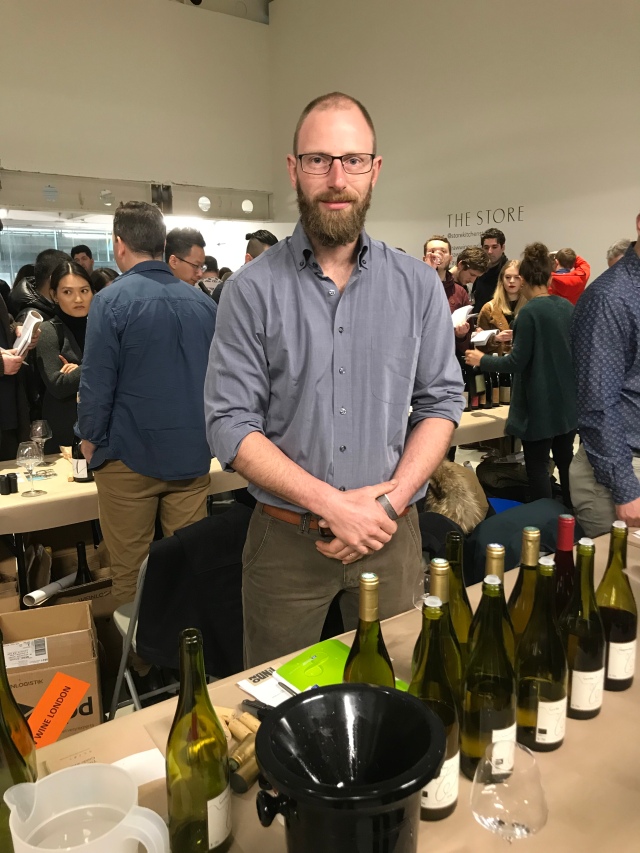
I look forward to continuing with Part 2 next week. My normal swiftness at getting the words out is being impaired by an unusually sociable week, which continues tomorrow at Noble Rot. In the meantime I thought I’d add in a few pictures of the pop-up shop from Burgess & Hall, which I mentioned above, and a few more from the after party dinner at The India Club, where everyone managed to bring along a delicious raw wine .
The exceptional selection at the Burgess & Hall pop-up shop at Raw this year
Raw After Party at The India Club – It’s party time and where the hell were you!















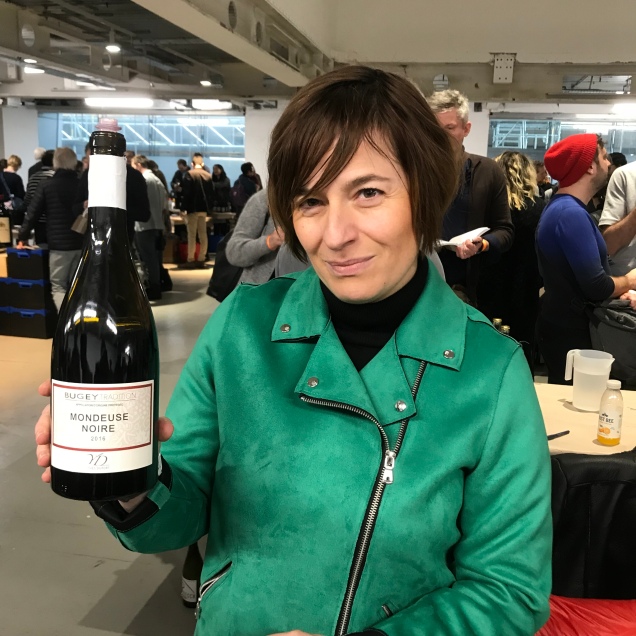
















Great to meet at the after party David!
Totally with you on Laurence Bannwarth. I was super impressed with the qvevri wines, enough that I’m going to squeeze them into a little tome I happen to be currently working on (shh!).
Also a fan of Vignobles de Reveur, and especially Un Instant sur terre. (Write-up here: https://www.themorningclaret.com/2018/le-vignoble-du-reveur-une-instant-sur-terre-2016/ )
LikeLiked by 1 person
Hello David
Thanks for your great comments about our wines from Domaine de Valmengaux! I could not say better!
Just one note that may desappoint you: prices are 18€ and 20€ (En Jarre) per bottle, in France. The price list at the fair were the export prices for the importers!
See you next year at Raw!
LikeLiked by 1 person
I’ve amended the prices, but they are still affordable.
LikeLike
I think so! Thank you
LikeLiked by 1 person
Great reading, sorry to have missed it now! Really enjoyed the Geschickt & Bannwarth wines when last in France. Hope they reach the UK shores soon.
LikeLiked by 1 person